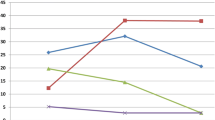Abstract
Population behaviour of two sets of pathotypes (77-5, 77-9, 104-2, 104-2; 77-5, 77-9, 104-2) of Puccinia triticina was studied in relation to wheat cultivars DBW71, DBW90, HD3086, HPW349, K1006, Local Wheat Hango (LWH), MP3336, PBW343, WH1124 and Agra Local at two temperature regimes under controlled greenhouse conditions. These wheat cvs belonged to different areas and were susceptible to all the pathotypes used in the studies. Predominance of a pathotype was the outcome of temperature, wheat variety and competition among the pathotypes. Both pathotype 77-9 and 104-2 were equally dominant in a population of 77-5, 77-9, 104-2 and 104-3. Pathotype 77-5 was less frequent. In a set of three pathotypes 77-5 was more frequent followed by 104-2 whereas 77-9 was nearly eliminated. Among the pathotypes used in the studies, 104-2 was the simplest and it emerged dominant on Agra Local and some other wheat cultivars. In fitness studies, pathotype 77-9 was found to possess less incubation period, latent period, produced more uredinio-pustules and urediniospores/cm2 as compared to other pathotypes. It is indicative of the fact that the pathotype 77-9 followed by 104-2 is more competitive and fit in population and can overtake other pathotypes in the years to come.
Similar content being viewed by others
References
Bartos P, Stuchlikova E, Hanusova R (1996) Adaptation of wheat rusts to the wheat cultivars in former Czechoslovakia. Euphytica 92:95–103
Bhardwaj SC (2012) Wheat rust pathotypes in Indian subcontinent then and now. In: Singh SS, Hanchinal RR, Gyanender S, Sharma RK, Saharan MS, Indu S (eds) Wheat-productivity enhancement under changing climate. Narosa Publishing House Pvt. Ltd, New Delhi, pp 227–238
Bhardwaj SC, Gangwar OP, Singh SB, Saharan MS, Sangeeta Sharma (2012) Rust situation and pathotypes of Puccinia species in Leh Laddakh in relation to recurrence of wheat rusts in India. Indian Phytopath 65:230–232
Bhardwaj SC, Neha Gupta, Sharma TR, Dharam Pal, Prasad P (2014) Competitive ability and fitness potential among the pathotypes of Puccinia triticina on wheat in India. Indian Phytopath 67:33–37
Bhardwaj SC, Prashar M, Subodh Kumar, Gangwar OP, Neha Gupta, Prasad P, Khan H (2016) Patterns of physiologic diversity of Puccinia triticina on wheat in Indian subcontinent during 2008–2013. Indian J Agric Sci 86:55–64
FAO Food Outlook (2016) Biannual report on global markets. FAO, Rome
Kapoor AS, Joshi LM (1981) Studies on slow rusting wheat. Indian Phytopath 34:169–172
Montarry J, Hamelin FM, Glais I, Corbiere R, Andrivon D (2010) Fitness costs associated with unnecessary virulence factors and life history traits: evolutionary insights from the potato late blight pathogen Phytophthora infestans. BMC Evol Biol 10:283
Oegla HJ, Brown JF (1971) Some factors affecting the relative ability of two strains of Puccinia graminis tritici to survive when mixed. Ann Appl Biol 67:157–168
Sache I, De Vallavieille-Pope C (1993) Comparison of the wheat brown and yellow rusts for monocyclic sporulation and infection processes and their polycyclic consequences. J Phytopathol 138:55–65
Stakman EC, Steward DM, Loegering WQ (1962). Identification of physiologic races of Puccinia graminis var. tritici. U.S. Dept. of Agriculture, Paper no. 4691, Scientific Journal Series,Minnesota Agricultural Experiment Station, ARS, E617, Minnesota, p 53
Van der Plank JE (1963) Plant diseases—epidemiology and control. Academic Press, New York, p 349
Veloukas T, Kalogeropoulou P, Markoglou AN, Karaoglanidis GS (2014) Fitness and competitive Ability of Botrytis cinerea field Isolates with dual resistance to SDHI and QoI fungicides, associated with several sdhB and the cytb G143A mutations. Phytopathology 104:347–356
Watson IA (1970) Change in virulence populations shifts in plant pathogens. Ann Rev Phytopath 8:209–230
Acknowledgements
Authors are grateful to Department of Biotechnology, Govt. of India, New Delhi for funding the research activities through the DBT Project ‘Puccinia triticina genomics network on De novo genome sequencing, fitness, variation and pathogenicity’ and Director, I.I.W.B.R., Karnal, Haryana for facilitating different research activities.
Author information
Authors and Affiliations
Corresponding author
Rights and permissions
About this article
Cite this article
Gupta, N., Bhardwaj, S.C., Sharma, T.R. et al. Population behaviour of predominant and virulent pathotypes of Puccinia triticina causing wheat brown rust in India. Indian Phytopathology 71, 59–64 (2018). https://doi.org/10.1007/s42360-018-0009-z
Received:
Accepted:
Published:
Issue Date:
DOI: https://doi.org/10.1007/s42360-018-0009-z




